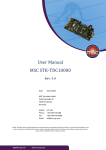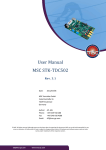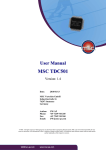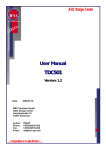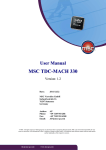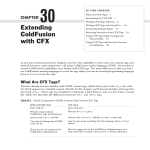Download User manual MSC STK-TDC
Transcript
User Manual MSC STK-TDC-Mach300 Rev. 1.0 Date: 2011/07/28 MSC Vertriebs GmbH Industriestraße 16 76297 Stutensee Germany Author: Phone: Fax: Email: AP, AKL +49 7249 910 288 +49 7249 910 4388 [email protected] © MSC. All rights reserved. Although great care has been taken in preparing this document, MSC can not be held responsible for any errors or omissions. All information in here is subject to change without notice. All hardware and software names used are trade names and/or trademarks of the respective owners. [email protected] www.msc-ge.com MSC Vertriebs GmbH User Manual - MSC STK-TDC-Mach300 Page 2 of 24 Contents 1 Introduction ............................................................................................................................................... 5 2 Installing the hardware.............................................................................................................................. 6 3 Installing and running the software .......................................................................................................... 7 4 3.1 Host software installation ................................................................................................................. 7 3.2 TDC starter kit measurement software overview ............................................................................. 8 3.3 Application software functions ......................................................................................................... 9 3.3.1 Connect/Disconnect button ...................................................................................................... 9 3.3.2 I/O history button ...................................................................................................................... 9 3.3.3 I/O protocol checkbox ............................................................................................................... 9 3.3.4 Hardware setting checkboxes ................................................................................................... 9 3.3.5 TDC reset button ..................................................................................................................... 10 3.3.6 User defined function buttons ................................................................................................ 10 3.3.7 Exit button ............................................................................................................................... 10 3.3.8 Input line .................................................................................................................................. 10 3.3.9 Protocol box............................................................................................................................. 10 3.3.10 Clear protocol button .............................................................................................................. 11 3.4 TDC starter kit measurement software commands ........................................................................ 11 3.5 User defined functions .................................................................................................................... 12 3.5.1 Channel resolution .................................................................................................................. 12 3.5.2 Single shot ............................................................................................................................... 12 3.5.3 N-times single shot .................................................................................................................. 13 Creating your own measurements programs.......................................................................................... 14 4.1 Software requirements.................................................................................................................... 14 4.2 Create your own C# project............................................................................................................. 14 4.3 Library MSCSTK-LIB .......................................................................................................................... 14 4.4 Function calls from MSCSTK-LIB ...................................................................................................... 15 4.4.1 Communication with the starter kit ........................................................................................ 15 4.4.2 Using the protocol box ............................................................................................................ 16 4.4.3 Initialisation the hardware and control the behaviour of the MSCSTKForm form elements . 17 4.4.4 Working with the OptionDialog form............................................................................... 19 4.5 Implementing your program into the GUI....................................................................................... 19 MSCSTKTDCMACH300RefManEngV10.docx [email protected] www.msc-ge.com Rev. 1.0 Author: AP, AKL MSC Vertriebs GmbH 5 User Manual - MSC STK-TDC-Mach300 Page 3 of 24 Appendix .................................................................................................................................................. 21 5.1 Specification .................................................................................................................................... 21 5.1.1 Common .................................................................................................................................. 21 5.1.2 Minimum system requirements .............................................................................................. 21 5.1.3 Power supply ........................................................................................................................... 21 5.1.4 Reset ........................................................................................................................................ 21 5.2 Layout diagrams / schematics ......................................................................................................... 22 Figures Figure 1: Evaluation board block diagram ......................................................................................................... 5 Figure 2: Connect the starter kit........................................................................................................................ 6 Figure 3: MSCSTKTDC-Installer software ........................................................................................................... 7 Figure 4: Start up screen of the starter kit host software ................................................................................. 7 Figure 5: Host software connected with a TDC-Mach300 starter kit ................................................................ 8 Figure 6: Select options dialog ........................................................................................................................ 14 Figure 7: Layout diagram TDC-Mach300 starter kit (top view) ....................................................................... 22 Figure 8: Schematic of the TDC-Mach300 starter kit (part 1) ......................................................................... 23 Figure 9: Schematic of the TDC-Mach300 starter kit (part 2) ......................................................................... 24 Tables Table 1: I/O history line description .................................................................................................................. 9 Table 2: Additional input line control commands ........................................................................................... 10 Table 3: Protocol box text types ...................................................................................................................... 10 Table 4: TDC-Mach300 opcodes for input line or user defined functions ...................................................... 11 Table 5: TDC-Mach300 hardware specific opcodes for input line or user defined functions ......................... 12 Table 6: MSCSTK-LIB defined forms ................................................................................................................ 14 Table 7: MSCSTK-LIB defined form elements and variables............................................................................ 15 Table 8: function Cmd() ................................................................................................................................... 15 Table 9: variable Result[] ................................................................................................................................. 16 Table 10: variable RunProgram ....................................................................................................................... 16 MSCSTKTDCMACH300RefManEngV10.docx [email protected] www.msc-ge.com Rev. 1.0 Author: AP, AKL MSC Vertriebs GmbH User Manual - MSC STK-TDC-Mach300 Page 4 of 24 Table 11: function WriteText() ........................................................................................................................ 16 Table 12: function WriteDebug() ..................................................................................................................... 16 Table 13: variable Color ................................................................................................................................... 16 Table 14: variable DebugMode ....................................................................................................................... 16 Table 15: function InitTDC()............................................................................................................................. 17 Table 16: function RestorePinSettings() .......................................................................................................... 17 Table 17: function SavePinSettings() ............................................................................................................... 17 Table 18: function Wait() ................................................................................................................................. 17 Table 19: variable AutoConnectButton ........................................................................................................... 17 Table 20: variable VersionLabel....................................................................................................................... 17 Table 21: variable WorkingProgressBar .......................................................................................................... 17 Table 22: variable CalClkPeriod ....................................................................................................................... 18 Table 23: variable GlobalTimeOutValue .......................................................................................................... 18 Table 24: structure TDC ................................................................................................................................... 18 Table 25: function GenericOptionsDialog() ..................................................................................................... 19 Table 26: function ShowConfiguration() ......................................................................................................... 19 Examples Example 1: I/O history ....................................................................................................................................... 9 Example 2: Protocol box .................................................................................................................................. 11 Example 3: Place a program on user function button 9 .................................................................................. 20 Example 4: button 9 output in protocol box ................................................................................................... 20 MSCSTKTDCMACH300RefManEngV10.docx [email protected] www.msc-ge.com Rev. 1.0 Author: AP, AKL MSC Vertriebs GmbH User Manual - MSC STK-TDC-Mach300 Page 5 of 24 1 Introduction In combination with a PC the MSC STK-TDC-Mach300 starter kit is an easy to use evaluation tool for the MSC Time to Digital Converter TDC-Mach300. The starter kit consists of the evaluation board and the necessary accessories. Figure 1 shows the block diagram of the evaluation board. It consists of a microprocessor which controls the communication between the TDC and the PC using an USB 1.1-interface. Three SMB-connectors are provided for high-precision time difference measurements between the startand two stop-inputs. With the RC-measuring ports resistance measurements can be executed. All important signals of the TDC chip are accessible for analyses (e.g.: logic analyser) via two connectors. Data bus USB 1.1interface M16C/60processor Address bus START TDC-Mach300 STOP Control lines Figure 1: Evaluation board block diagram The starter kit provides the following components: 1 power supply unit, Imin = 500 mA 1 evaluation board 1 CD including software and documentation 2 measurement cables 1 user manual MSCSTKTDCMACH300RefManEngV10.docx [email protected] www.msc-ge.com Rev. 1.0 Author: AP, AKL MSC Vertriebs GmbH User Manual - MSC STK-TDC-Mach300 Page 6 of 24 2 Installing the hardware First of all the evaluation board has to be powered by connecting the provided power supply unit to the connector X201 (see figure 7). The red Power-LED (D201) turns on. After this the evaluation board has to be connected to an USB-port of the PC using an A/B USB-cable. The green Run-LED (D202) turns on and indicates the correct operation of the M16C-processor. The evaluation board is ready-to-operate. 2. Connect to a PC 1. Connect to power supply 3. Connect your measurement environment or your application Figure 2: Connect the starter kit MSCSTKTDCMACH300RefManEngV10.docx [email protected] www.msc-ge.com Rev. 1.0 Author: AP, AKL MSC Vertriebs GmbH User Manual - MSC STK-TDC-Mach300 Page 7 of 24 3 Installing and running the software 3.1 Host software installation The software is delivered on the starter kit CD. Driver software, libraries and source codes are provided. The starter kit software with driver and all provided sources can be installed by starting the installer executable “MSCSTKTDC-Installer.exe”. You must have administration rights. Follow the instructions of the install program. Afterwards the software is ready to operate. Figure 3: MSCSTKTDC-Installer software First of all ensure that the USB-driver ‘CDC_Demo.inf’ has been installed successfully. Otherwise power the starter kit, connect it to your PC and try to install the driver manually. The driver is on the CD. The starter kit software is started by double-clicking on the file “TDC Starter Kit Measurement Software.exe”. The program’s application window appears. Figure 4: Start up screen of the starter kit host software MSCSTKTDCMACH300RefManEngV10.docx [email protected] www.msc-ge.com Rev. 1.0 Author: AP, AKL MSC Vertriebs GmbH User Manual - MSC STK-TDC-Mach300 Page 8 of 24 If the starter kit is powered and connected to the host, the software connects to the kit. Otherwise you can connect the starter kit to the software by pressing the “Connect”-button. After successful connection the software shows you the connected kit. The green Run-LED turns off and the MSC STK-TDC-MACH300 application window sets up as shown in figure 5. Figure 5: Host software connected with a TDC-Mach300 starter kit 3.2 TDC starter kit measurement software overview The application window of the host software provides the following information and functions: Information about the connection status (upper right corner) Command input line on the top Protocol box for information, debug and dataflow outputs Program buttons and checkboxes on the right User defined function buttons on the right MSCSTKTDCMACH300RefManEngV10.docx [email protected] www.msc-ge.com Rev. 1.0 Author: AP, AKL MSC Vertriebs GmbH User Manual - MSC STK-TDC-Mach300 Page 9 of 24 3.3 Application software functions 3.3.1 Connect/Disconnect button The “Connect”- button connects the software with the starter kit hardware. After the kit is connected, the software and the hardware are synchronised. The hardware setting checkboxes show the current status of the control pins and the button has changed its function to “Disconnect”. 3.3.2 I/O history button The I/O history button shows a list of all transactions between the host software and the starter kit. Each entry has following information: 15:15:58,629 [0007]: COM8 G O [ 15:15:58,629 Time stamp [0007]: List entry number COM8 Com port G Command status: G Good F Fail 0006] LED_OFF O [ 0006] Data Command number or direction: command reference I Input O Output ? Unknown Table 1: I/O history line description LED_OFF Transferred data Example 1: I/O history 10:30:37,745 10:30:37,753 10:30:37,778 10:30:37,783 10:30:37,808 [0018]: [0019]: [0020]: [0021]: [0022]: COM8 COM8 COM8 COM8 COM8 G G G G G I O I O I [ACK [ [ACK [ [ACK 0011] 0012] 0012] 0013] 0013] # WR_CTRL_REG 04 # RD_VALID # This example shows the both commands “WR_CTRL_REG 04” and “RD_VALID” send from the host software to the starter kit and the received acknowledge “#” from the starter kit. 3.3.3 I/O protocol checkbox If this checkbox is enabled, each data transfer between host software and starter kit is shown in the protocol box. Please consider that this function will slow down the application. It should be used only for debug purposes. Otherwise all data transfers could be displayed using the I/O history button. 3.3.4 Hardware setting checkboxes The hardware setting checkboxes define the current status of the TDC control pins, the green Run-LED and the starter kit oscillator. E.g. ticking the ‘LED on’ checkbox will light the green Run-LED on the starter kit. ‘LED on’: Switches on and off the green Run-LED of the microprocessor. ‘OSC enable’: Enables and disables the TDC-calibration clock oscillator. ‘SPI Slave Select’: Enables (SPI slave selected) and disables (SPI in reset) the TDC’s SPI Slave Select pin SSN. ‘SPI’ / ‘PIO’: Communication between M16C-processor and TDC via SPI (TDC-pin SPI_EN = ‘1’) or via the parallel interface (SPI_EN = ‘0’). Default settings after software connection are: LED off, oscillator disabled, SPI in reset (TDC-pin SSN = ‘1’) and parallel interface selected. MSCSTKTDCMACH300RefManEngV10.docx [email protected] www.msc-ge.com Rev. 1.0 Author: AP, AKL MSC Vertriebs GmbH 3.3.5 User Manual - MSC STK-TDC-Mach300 Page 10 of 24 TDC reset button The reset button resets the TDC by sending a low active reset pulse on the RSTN pin of the TDC. This button does not neither synchronise the software with the hardware nor manipulate any hardware setting. Default setting after software connection is: TDC-reset pin inactive (TDC-pin RSTN = ‘1’). 3.3.6 User defined function buttons The user defined buttons are for the example programs, delivered with the software or appended by the starter kit user. Here you can add your own functionality. 3.3.7 Exit button The exit button disconnects the starter kit and closes the application. All information like I/O history or protocol box will be lost. 3.3.8 Input line The input line allows the user to control the TDC starter kit by input of commands described in chap. 3.4. Furthermore this line allows controlling some features of the host software: Input line command Function Enables debug outputs DEBUG_OFF Disables debug outputs CALCLKPERIOD value Change the calibration clock period to value GLOBALDEBUGLEVEL Filter the debug outputs by change the debug level between X and Y . Shows the internally stored values of the TDC structure HELP Show all available commands for the input line DEBUG_ON Table 2: Additional input line control commands The input line supports line editing and history scrolling function by the cursor keys. 3.3.9 Protocol box The protocol box shows information of the software. The text types of the protocol box text can be: Text type Titles Information Errors Debug Color DarkCyan DarkGreen Red DarkGray Text Type Data input Data output I/O history Help Color DarkMagenta Brown Black MidnightBlue Table 3: Protocol box text types The protocol box is scrollable and supports select and copy functions. The copy supports RTF styles. MSCSTKTDCMACH300RefManEngV10.docx [email protected] www.msc-ge.com Rev. 1.0 Author: AP, AKL MSC Vertriebs GmbH User Manual - MSC STK-TDC-Mach300 Page 11 of 24 Example 2: Protocol box Search for connected starter kit hardware... Connected with USB starter kit MSCSTK-TDCMACH-300 > LED_ON < # Determination of the TDC resolution by 1 calibration measurements > < > < > < [tCAL = 0,25 µs] OSC_EN # PU_RESET # SPI_RESET_ON # 3.3.10 Clear protocol button The clear button clears the protocol box contents. Furthermore it clears the I/O- and commands history. 3.4 TDC starter kit measurement software commands After connection with the starter kit hardware the host software allows the user to operate with the hardware. The user can input commands using the input line or can run a collection of commands written as a function for one of the user defined function buttons. Each command has the following structure: Opcode [Parameter] To communicate with the starter kit the following list of opcodes is available for the input line and the program source code. Other data send to the starter kit are misinterpreted and result in an error message. Opcode Parameter Description WR_CTRL_REG 8 Bit Hex Control Register RD_CTRL_REG -Control Register RD_STATUS_REG -Status Register RD_CAL1_L -Calibration value CAL1: Low byte RD_CAL1_H -Calibration value CAL1: High byte RD_CAL2_L -Calibration value CAL2: Low byte RD_CAL2_H -Calibration value CAL2: High byte RD_VAL_L -Measurement value VAL: Low byte RD_VAL_H -Measurement value VAL: High byte Note: Pin EN_SPI = 0: Opcode-execution via parallel interface, EN_SPI = 1: Execution via SPI Return value -8 Bit Hex 8 Bit Hex 8 Bit Hex 8 Bit Hex 8 Bit Hex 8 Bit Hex 8 Bit Hex 8 Bit Hex Access mode wr rd rd rd rd rd rd rd rd Table 4: TDC-Mach300 opcodes for input line or user defined functions MSCSTKTDCMACH300RefManEngV10.docx [email protected] www.msc-ge.com Rev. 1.0 Author: AP, AKL MSC Vertriebs GmbH User Manual - MSC STK-TDC-Mach300 Page 12 of 24 Opcode Parameter Description Return value (Hex) RD_VALID RD_OV MESS_MULTI --Number of measurements: 16 Bit Hex (max=0x07d0) 0x00 or 0x01 0x00 or 0x01 n*6 Byte Hex: CAL1 (low, high), CAL2 (low, high), VAL (low, high) INIT_SYSTEM RESET_ON RESET_OFF LED_ON LED_OFF OSC_EN OSC_DIS PU_RESET ENABLE_SPI DISABLE_SPI ----------- SPI_RESET_ON SPI_RESET_OFF 1 WRITE_SPI_0 ---- Reads TDC’s pin VALID Reads TDC’s pin OV High-speed cycle of n single shot measurements with automatic calibration (tCAL= 250ns, tMIN= 50ns, tMAX= 750ns, auto noise; interface depends on pin EN_SPI) Message: STK-TDC-MACH300 is up !!!! Puts the reset line to ‘0’ Puts the reset line to ‘1’ Switch-on M16C’s green Run-LED Switch-off M16C’s green Run-LED Enables TDC-calibration clock Disables TDC-calibration clock Reset-pulse for the TDC on pin RSTN Puts the EN_SPI line to ‘1’: SPI selected Puts the EN_SPI line to ‘0’: Parallel Interface selected Puts the SSN line to ‘1’: SPI is in reset Puts the SSN line to ‘0’: SPI Slave Select Writes ‘0’ to the MOSI line, reads one bit of the MISO line Writes ‘1’ to the MOSI line, reads one bit of the MISO line WRITE_SPI_1 1 -- Access Mode rd rd wr/rd ----------- rd wr wr wr wr wr wr wr wr wr --0x00 or 0x01 wr wr wr/rd 0x00 or 0x01 wr/rd Table 5: TDC-Mach300 hardware specific opcodes for input line or user defined functions 3.5 User defined functions On the right side of the application window you find ten ‘User defined functions’-buttons. Some of them are predefined; all other are provided for creating your own measurement programs (see chap. 4). 3.5.1 Channel resolution Clicking on the ‘channel resolution’-button will find out the TDC’s resolution using the interface, selected by the hardware settings PIO/SPI. Therefor the number of calibration measurements has to be entered within a pop-up window. The calibration values CAL1, CAL2 and the actual resolution of each measurement are displayed in the protocol box. At the end of the measurements the standard deviations of CAL1 and CAL2 and the average resolution are displayed. The calibration measurements are performed with a calibration clock period of tCAL = 250ns. 3.5.2 Single shot Clicking on the ‘single shot’-button will start a single shot time difference measurement with automatic calibration using the interface, selected by the hardware settings PIO/SPI. The program waits for one rising edge on both the start-input START (connector X301) and the stop-input STOP (connector X303). The program executes a waiting loop. The waiting loop will be exited if either a start-stop event takes place 1 Correct execution only when Pin EN_SPI = 1 and Pin SSN = 0 MSCSTKTDCMACH300RefManEngV10.docx [email protected] www.msc-ge.com Rev. 1.0 Author: AP, AKL MSC Vertriebs GmbH User Manual - MSC STK-TDC-Mach300 Page 13 of 24 (correct execution) or a predefined waiting time has exceeded (error message). If a start-stop event takes place, the measurement result is calculated and displayed in the protocol box. The minimum measurement period is tMIN = 50ns (3.3V, 25°C) and the maximum measurement period is tMAX = 750ns. The automatic calibration measurement is performed with a calibration clock period of tCAL = 250ns. Note: Remove jumpers JP301 and JP303 (see figure 7) before the measurement because of accuracy reasons. 3.5.3 N-times single shot Clicking on the ‘n-times single shots’-button will start a high-speed cycle of n single shot time difference measurements with automatic calibration and auto noise using the interface, selected by the hardware settings PIO/SPI. At first the number of measurements (≤ 2000) has to be entered within a pop-up window. Then the program awaits n start-stop measurements with rising edges on both the start-input START (connector X301) and the stop-input STOP (connector X303). Before each measurement the program executes a waiting loop. Each waiting loop will be exited if either a start-stop event takes place (correct execution) or a predefined waiting time has exceeded (error message). If all n start-stop events take place before the MESS_MULTI-command’s timeout is reached (see table 8) all the n measurement results are calculated and displayed in the protocol box together with the minimum, the maximum and the average measurement time and the standard deviation. Otherwise an error message is generated. The minimum measurement period of each measurement is tMIN = 50ns and the maximum measurement period is tMAX = 750ns. The automatic calibration measurements are performed with a calibration clock period of tCAL = 250ns. Note: Remove jumpers JP301 and JP303 (see figure 7) before the measurements because of accuracy reasons. MSCSTKTDCMACH300RefManEngV10.docx [email protected] www.msc-ge.com Rev. 1.0 Author: AP, AKL MSC Vertriebs GmbH User Manual - MSC STK-TDC-Mach300 Page 14 of 24 4 Creating your own measurements programs 4.1 Software requirements To create your own measurement programs you have to fulfil the system requirements of the starter kit software and to install a C# development suite. In the following chapter we apply to the Microsoft Visual C# 2008 Express Edition. 4.2 Create your own C# project First you have to set up a new project using the predefined template “Windows Form application”. Afterwards you have to add the necessary files to your project. First step is adding a link to the MSCSTK-LIB (mscstk-lib.dll) which is found in the source code directory of the install CD. Then add the existing elements “Program.cs”, “TDC300.cs”, “TDC330.cs”, “TDC501.cs”, “TDC502.cs”, “TDC10000.cs” and “UserButtons.cs” which can be found also in the source code directory of the install CD. Please overwrite the already “Program.cs” by the delivered one. Now you should be able to compile the basic program for the first time. After starting the executable a window like figure 4 should appear. If this window does not appear, check if the file “Program.cs” initialises the right application form: Application.Run(new MyMSCSTKForm()); The form1 which is initialised with the new Project is not necessary and may be deleted. 4.3 Library MSCSTK-LIB To create your own test programs you have the complete language range of C# with all .NET- functions available. Additionally we have included some functions in our MSCSTK-LIB to enhance your programming success. This library has to be linked to your project. Otherwise you don’t have the main application form and all the functions to communicate with the starter kit. Following forms are available in MSCSTK-LIB: MSCSTKForm Standard application form as shown in figure 5. OptionDialog Options dialog to set up various TDC or program parameters. Figure 6: Select options dialog Table 6: MSCSTK-LIB defined forms MSCSTKTDCMACH300RefManEngV10.docx [email protected] www.msc-ge.com Rev. 1.0 Author: AP, AKL MSC Vertriebs GmbH User Manual - MSC STK-TDC-Mach300 Page 15 of 24 A TDCStruct structure is implemented in MSCSTK-LIB. This structure contains the complete setting of the TDC and some program options. Furthermore the following functions are available from MSCSTK-LIB: int Cmd(string message, Int32 TimeOutValue) int Cmd(string message) void GenericOptionsDialog(bool OneChannel, bool Resolution, bool Measurements) void InitTDC(int Mode) void RestorePinSettings() void SavePinSettings() void ShowConfiguration(int Mode) void Wait(Int32 ms) void WriteDebug(string message) void WriteText(string message, Color color) void WriteText(string message, Color color, FontStyle style) At least a number of variables and all necessary form elements are marked as public. Form elements Global variables AutoConnectButton VersionLabel WorkingProcessBar double CalClkPeriod int GlobalTimeOutValue int[] Result bool DebugMode bool RunProgram Color DbgColor Color ErrColor Color HisColor Color InfColor Color InpColor Color OutColor Color TitColor Color HlpColor TDCStruct TDC Table 7: MSCSTK-LIB defined form elements and variables 4.4 Function calls from MSCSTK-LIB 4.4.1 Communication with the starter kit Function call: Description: Parameter: Return value: int Cmd(string command [, Int32 TimeOutValue]) The function Cmd sends the command to the starter kit and receives the reply. The function call without a TimeOutValue uses the GlobalTimeOutValue. The time out value is used for the port communication. command a valid opcode, optionally with parameters (see table 4 and table 5) TimeOutValue Time out value in ms -2 The function was not executed, because the global variable RunProgram was false. -1 The function fails. Usually there is an error description message in the protocol box. others The function was executed successfully. The number of results which are stored in the integer array variable Result is returned. Table 8: function Cmd() MSCSTKTDCMACH300RefManEngV10.docx [email protected] www.msc-ge.com Rev. 1.0 Author: AP, AKL MSC Vertriebs GmbH Variable: Description: User Manual - MSC STK-TDC-Mach300 Page 16 of 24 int[] Result This array contains the result values from the last successfully executed command. Attention: Only as many result values as returned from the function Cmd are updated! Table 9: variable Result[] Variable: Description: bool RunProgram This variable is used to control the function call executions. If it turns to false, a function call was unsuccessfully and all further function calls of the MSCSTK-LIB will not be executed. Table 10: variable RunProgram 4.4.2 Using the protocol box Function call: Description: Parameter: Return value: void WriteText(string message, Color color [, FontStyle style]) The function WriteText outputs the string message to the protocol box. The text color color is necessary; using a font style is optionally. message Output string color Color setting for the output text style Font style setting for the output text n/a Table 11: function WriteText() Function call: Description: Parameter: Return value: void WriteDebug(string message) The function WriteDebug outputs the string message to the protocol box. message Output string n/a Table 12: function WriteDebug() Variable: Description: Color Color Example: This line was written as a additonal text fo debug features usign the colour "DbgColor". If an Error occurs you will see this with the colour "ErrColor". The normal text output is done usign the colour "InfColor". If you press the history button, the history is printed with "HisColor". Usually the title drawed usign "TitColor" is on the top of your measurement application. Table 13: variable Color Variable: Description: bool DebugMode The colour variables are used as the predefined colours for the output messages on the protocol box. The values are changeable. Predefined are following colours: DbgColor DarkGray Debug outputs ErrColor Red Error messages HisColor Black History table colour InfColor DarkGreen Normal (information) text outputs InpColor DarkMagenta Colour used for port input messages OutColor Brown Colour used for port output messages TitColor DarkCyan Title colour This variable is to enable you a debug mode, e.g. for additional outputs. Table 14: variable DebugMode MSCSTKTDCMACH300RefManEngV10.docx [email protected] www.msc-ge.com Rev. 1.0 Author: AP, AKL MSC Vertriebs GmbH 4.4.3 User Manual - MSC STK-TDC-Mach300 Page 17 of 24 Initialisation the hardware and control the behaviour of the MSCSTKForm form elements Function call: Description: Parameter: Return value: void InitTDC() The function InitTDC has to be used to initialise the starter kit and to synchronise the application software with the starter kit. The default settings are described in Table 24: structure TDC. n/a n/a Table 15: function InitTDC() Function call: Description: Parameter: Return value: void RestorePinSettings() The function RestorePinSettings() loads the saved TDC structure program settings to the GUI an initialised the starter kit afterwards with this settings. n/a n/a Table 16: function RestorePinSettings() Function call: Description: Parameter: Return value: void SavePinSettings() The function SavePinSettings() has to be used to save current program settings in the TDC structure. n/a n/a Table 17: function SavePinSettings() Function call: Description: Parameter: Return value: void Wait(Int32 ms) The function Wait can be used to stop the current software process and to wait a defined time ms ms Time to wait in milliseconds n/a Table 18: function Wait() Variable: Description: Button AutoConnectButton This is the Connect/Disconnect Button of the GUI. It’s useful to combine the initialisation of your special GUI elements and settings with this button. Table 19: variable AutoConnectButton Variable: Description: label VersionLabel This label is partly predefined. It contains the version information of MSCSTK-LIB. You can use this element to mark your software version. It is displayed below the GUI title. Table 20: variable VersionLabel Variable: Description: ProgressBar WorkingProgressBar The progress bar is used to show that a measurement program or others are running. This is done by increase the value of the progress bar. Table 21: variable WorkingProgressBar MSCSTKTDCMACH300RefManEngV10.docx [email protected] www.msc-ge.com Rev. 1.0 Author: AP, AKL MSC Vertriebs GmbH Variable: Description: User Manual - MSC STK-TDC-Mach300 Page 18 of 24 double CalClkPeriod This variable is predefined with 250 ns and corresponds with the used 4MHz oscillator on the starter kit board. Table 22: variable CalClkPeriod Variable: Description: int GlobalTimeOutValue This variable is to modify the time out behaviour of the application. The default value is 10000 ms. Table 23: variable GlobalTimeOutValue Variable: Description: TDCStruct TDC This structure stores all settings of all supported TDC starter kits. Additionally all selections made in the OptionDialog Form are stored in this structure. The following values are the predefined values, which can be always set by InitTDC(): Value Starter kit Connection status: Default Description TDC.Connected: TDC.NotInitialized: TDC.Typ: TDC.UART: TDC.Name: 2 2 2 2 2 Connection status (boolean) Initialisation status (boolean) TDC number (e.g. “502” = TDC502) UART or USB connection (boolean) TDC name string (e.g. “TDC502”) Starter kit hardware settings: TDC.LED: TDC.OSC: TDC.SPI: TDC.ENSPI: TDC.MODE0: TDC.MSDI: TDC.NOEN: TDC.NSTA: TDC.NSTP: TDC.EN_STOP_A: TDC.EN_STOP_B: TDC.PINENA0: TDC.PINENA1: False False False False True False False False False False False False False Green Run-LED (on=true) Starter kit oscillator (on=true) Use SPI (TDC-MACH-3*0) Enable SPI (TDC-MACH-3*0) MODE0 (TDC501) MSDI (TDC501) NOEN (TDC501) NSTA (TDC501) NSTP (TDC501) Enable STOP_A (TDC502) Enable STOP_B (TDC502) Enable channel 0 (TDC10000) Enable channel 1 (TDC10000) 10 True False 4 OptionsDialog variable OptionsDialog variable (TDC10000, TDC502) OptionsDialog variable (TDC10000, TDC502) OptionsDialog variable (TDC502) 4 Clock divider setting3 OptionsDialog variables: TDC.NumberOfMeasurements: TDC.ChannelASelect: TDC.ChannelBSelect: TDC.Resolution: Clock divider variable: TDC.CalDiv: Table 24: structure TDC 2 If connected with a starter kit, these variables get their starter kit specific value. 3 This variable is only for the software and is not the same as the clock divider setting within the TDC. MSCSTKTDCMACH300RefManEngV10.docx [email protected] www.msc-ge.com Rev. 1.0 Author: AP, AKL MSC Vertriebs GmbH 4.4.4 User Manual - MSC STK-TDC-Mach300 Page 19 of 24 Working with the OptionDialog form Function call: void GenericOptionsDialog(bool Measurements) Description: This function shows the OptionDialog. The dialog form has to be initialised using the parameters. Channel Shows radio button box “Select channel” with selection between channel A and B, only one channel can be activated (TDC10000, TDC502) Resolution Shows the radio button box “Select resolution” with 4 values: 1=half, 0=normal, 2=high, 4=smart (TDC502) Measurements Shows a text input line to set the number of measurements n/a see figure 6: select options dialog Parameter: Return value: Example: Channel, bool Resolution, bool GenericOptionsDialog(true, true, true) Table 25: function GenericOptionsDialog() Function call: Description: Parameter: Return value: Example: void ShowConfiguration(int Mode) This function shows the configuration selected by the OptionDialog form and the selected measurement mode Mode in the protocol box. Mode Shows the selected measurement mode Mode. n/a ShowConfiguration(7); Your selected Channel(s): Resolution: Measurements: Mode : configuration: A smart 10 7 Table 26: function ShowConfiguration() 4.5 Implementing your program into the GUI The delivered template file “UserButtons.cs” can be used to implement your own measurement application in the starter kit application software. This file initialises an own MSCSTK Form MyMSCSTKForm with 10 additional UserFunctionButton[] user function buttons. To initialise the buttons a UserConnectButtonHandler handler is started with the AutoConnectButton button click. The UserConnectButtonHandler handler defines the button text according to the used starter kit if it is connected. Otherwise all user function buttons are set invisible. If a user function button was clicked, the UserFunctionButtonHandler handler is called. According to the pressed user button and the used TDC a measurement function is called. There are a number of predefined function calls for the user function buttons. MSCSTKTDCMACH300RefManEngV10.docx [email protected] www.msc-ge.com Rev. 1.0 Author: AP, AKL MSC Vertriebs GmbH User Manual - MSC STK-TDC-Mach300 Page 20 of 24 Example 3: Place a program on user function button 9 Add to the function UserFunctionButtonHandler: case 9: { // Program control variable must be activated! RunProgram = true; // Title WriteText(Environment.NewLine + "My first user measurement program!", TitColor); // Output the connected TDC-Type and some settings... WriteText("Get settings:", InfColor, FontStyle.Underline); WriteText("Connected TDC from starter kit is " + TDC.Name + ".", InfColor); WriteText("The oscillator is " + (TDC.OSC ? "on" : "off") + ".", InfColor); // Switch on the oscillator if(! TDC.OSC) Cmd("OSC_EN"); WriteText("Now the oscillator is " + (TDC.OSC ? "on" : "off") + ".", InfColor); // 10 times LED blink WriteText("Take a look at the blinking green LED...", InfColor); for (int myTempInt = 0; myTempInt < 10; myTempInt++) { if (TDC.LED) Cmd("LED_OFF"); else Cmd("LED_ON"); Wait(100); // wait for 0.5s to see a blinking LED! } // Switch the LED on finally if (!TDC.LED) Cmd("LED_ON"); WriteText("Now the green LED is " + (TDC.LED ? "on" : "off") + ".", InfColor); // Finish break; } Add to the function UserConnectButtonHandler under the if construct if (TDC.Connected): // My user function button 9 UserFunctionButton[9].Text = "My 1st function"; If the compiled application runs, press the Connect button and afterwards the user function button 9. You should see a blinking green LED on the starter kit and the following text in the protocol box: Example 4: button 9 output in protocol box My first user measurement program! Get settings: Connected TDC from starter kit is TDC-MACH 300. The oscillator is off. Now the oscillator is on. Take a look at the blinking green LED... Now the green LED is on. Program execution was successful. MSCSTKTDCMACH300RefManEngV10.docx [email protected] www.msc-ge.com Rev. 1.0 Author: AP, AKL MSC Vertriebs GmbH User Manual - MSC STK-TDC-Mach300 Page 21 of 24 5 Appendix 5.1 Specification 5.1.1 5.1.2 5.1.3 Common 32 MHz M16C/60-microprocessor. Time-to-Digital Converter TDC-Mach300. Control pins of the TDC are configurable via microprocessor. 2 SMB measurement-inputs for high precision time difference measurements. 4 MHz oscillator, used as TDC-calibration clock (30ppm). Red LED for power-on indication. Green LED for indication of correct microprocessor operation. Communication between PC and evaluation board via USB 1.1. Minimum system requirements PC with USB 1.1 interface. Operating system: Windows XP, Windows Vista, Windows 7 with .NET-framework 3.5 or later 4 Measurement inputs with 3,3V/5V compatible ports for start and stop. Power supply Standard universal power supply connected to X201; min. 9V up to max. 12 V AC/DC. Maximum current consumption of the board: approx. 200 mA. To guarantee a high degree of signal integrity the board provides two independent supply voltages, one for the TDC chip and one for the microprocessor. So the power supply of the TDC chip is not affected and disturbed by other components. The TDC’s supply voltage is adjustable via the potentiometer R209 within the voltage range of 2,7V up to 5,5V. The supply voltage of the microprocessor and all other components is adjustable via the potentiometer R225 within the voltage range of 3,0V up to 5,5V. Caution: The values of the two supply voltages may not differ from each other more than 0,5V! 5.1.4 Reset When the board is connected to the power supply, the board’s reset chip runs a power-on reset cycle. This resets the microprocessor and the TDC chip as well. If the supply voltage of the microprocessor drops to values less than 3,0V a reset may occur, too. 4 The application software was tested using Windows XP Professional Edition 32-bit and Windows 7 Professional 64-bit MSCSTKTDCMACH300RefManEngV10.docx [email protected] www.msc-ge.com Rev. 1.0 Author: AP, AKL MSC Vertriebs GmbH User Manual - MSC STK-TDC-Mach300 Page 22 of 24 5.2 Layout diagrams / schematics Figure 7 shows the top view of the board’s layout diagram and Figure 8 and Figure 9 show its schematics. The board’s connector X301 is connected to the TDC’s pin START, X303 is connected to STOP. Figure 7: Layout diagram TDC-Mach300 starter kit (top view) MSCSTKTDCMACH300RefManEngV10.docx [email protected] www.msc-ge.com Rev. 1.0 Author: AP, AKL MSC Vertriebs GmbH User Manual - MSC STK-TDC-Mach300 Figure 8: Schematic of the TDC-Mach300 starter kit (part 1) MSCSTKTDCMACH300RefManEngV10.docx [email protected] www.msc-ge.com Rev. 1.0 Author: AP, AKL Page 23 of 24 MSC Vertriebs GmbH User Manual - MSC STK-TDC-Mach300 Figure 9: Schematic of the TDC-Mach300 starter kit (part 2) MSCSTKTDCMACH300RefManEngV10.docx [email protected] www.msc-ge.com Rev. 1.0 Author: AP, AKL Page 24 of 24
























